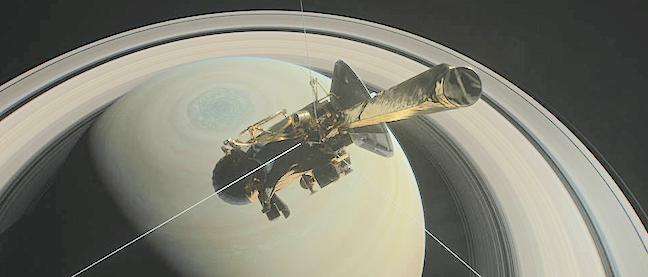
NASA’s Cassini spacecraft began the first in a series of dives through the 1,500-mile gap between Saturn and its rings on April 26 with the help of onboard bipropellant and monopropellant thrusters made by Aerojet Rocketdyne

NASA's Cassini satellite carefully slipped between the gap of Saturn and its rings thanks to Aerojet Rocketydyne's (NYSE:AJRD) onboard bipropellant and monopropellant thrusters provided the energy for the series of dives to take place through the 1,500 mile gap.
Over the next five months, the Aerojet Rocketdyne 16 MR-103H 0.2 lbf monopropellant thrusters will guide Cassini through its final days, helping the spacecraft obtain the first-ever sampling of Saturn’s atmosphere and particles from the main rings, as well as the closest-ever views of Saturn’s clouds and inner rings, before the spacecraft’s deliberate plunge into the planet on September 15.
Aerojet Rocketdyne CEO and President Eileen Drake commented that it’s a great honor to know that their thrusters will guide Cassini on such a perilous journey through Saturn’s rings, helping scientists uncover the mysteries of a planet that has excited and amazed astronomers through the ages. They look forward to seeing all the discoveries this unparalleled mission still has in store for all of us.
Jerry Tarnacki, senior vice president of Aerojet Rocketdyne’s Space Systems Business Unit added that everyone who has been involved in this mission should be proud—from those who developed the liquid rocket engines used on the spacecraft’s launch nearly 20 years ago—to those responsible for the thrusters used on its extraordinary final chapter through Saturn’s rings. This mission would not be possible without the entire team’s work and dedication.
Aerojet Rocketdyne has played an instrumental role in all aspects of the Cassini mission, which began its 2.2 billion-mile journey to Saturn in October 1997. The company provided the first- and second-stage liquid rocket engines for the spacecraft’s Titan IV launch vehicle and 12 monopropellant engines on the Centaur upper stage. The company’s R-4D 100-lbf bipropellant engine slowed the spacecraft for capture by Saturn’s gravity and has been used for major trajectory changes throughout the mission, including setting up the Grand Finale. Aerojet Rocketdyne also provided 16 MR-103H 0.2 lbf monopropellant hydrazine engines for use throughout the mission and during the Saturn Orbit Insertion in 2004. Cassini carries a pair of R-4D bipropellant engines; however, the backup engine has never been used.
NASA’s Cassini mission has been one of the most ambitious and successful exploration missions ever conducted. Cassini has made startling discoveries throughout the Saturnian system, including liquid methane seas on its largest moon, Titan, and liquid water oceans beneath the frozen outer layer of its sixth-largest moon, Enceladus. A deliberate end to an interplanetary mission is preferable to running out of fuel and potentially losing control of the spacecraft. In 2010, in the face of dwindling fuel supplies, NASA decided to end the mission with a planned plunge into Saturn to preclude the possibility of crashing into Enceladus (which could or may have hosted life), or contaminating other moons, especially Titan. According to NASA, the space agency wants to protect Saturn’s moons for future exploration.
This is not the first time NASA has ended an orbiting mission with a fiery re-entry into a planet. Aerojet Rocketdyne propulsion has facilitated the end of NASA’s Magellan and Mercury MESSENGER missions, among others. In late 2016, the Cassini spacecraft began its penultimate set of orbits called the ring-grazing orbits, using Aerojet Rocketdyne’s onboard bipropellant and monopropellant rocket engines. The R-4D main engine was fired to initiate the trajectory, in which Cassini passed just outside of Saturn’s main rings 20 times. It was the 183rd and last planned firing of the main engine, and all remaining maneuvers are planned to be completed using Aerojet Rocketdyne’s MR-103H thrusters.
On April 22, the last flyby of Saturn’s moon Titan reshaped Cassini’s flight path to begin the mission’s Grand Finale phase, leaping over the rings and making the first of 22 plunges through the 1,500-mile-wide gap between Saturn and its innermost ring. On September 15, the mission’s planned conclusion will be a final dive into Saturn’s atmosphere.
During Cassini’s final orbits, the mission team hopes to gain insights into the planet’s internal structure and the origins of the rings; obtain the first-ever sampling of Saturn’s atmosphere and particles coming from the main rings; and capture the closest-ever views of Saturn’s clouds and inner rings.

